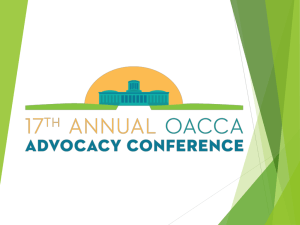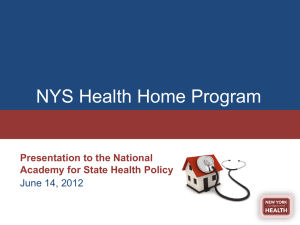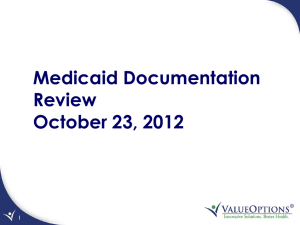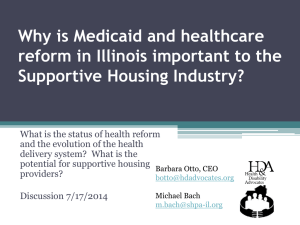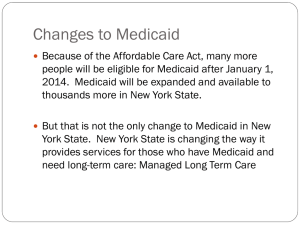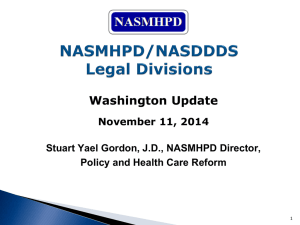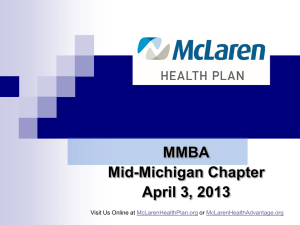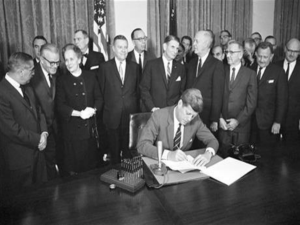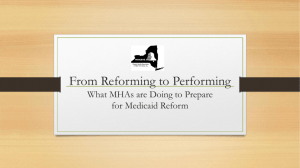ACROMYS GONE WILD - Mental Health America
advertisement
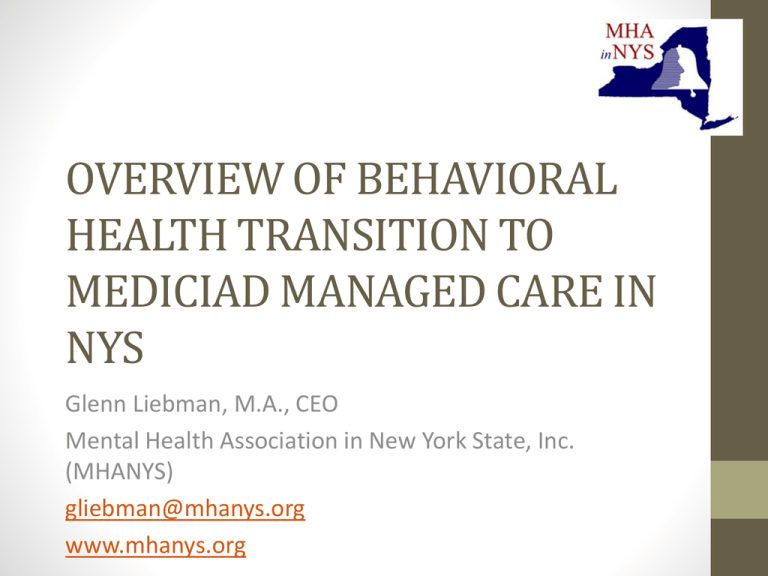
OVERVIEW OF BEHAVIORAL HEALTH TRANSITION TO MEDICIAD MANAGED CARE IN NYS Glenn Liebman, M.A., CEO Mental Health Association in New York State, Inc. (MHANYS) gliebman@mhanys.org www.mhanys.org ACRONYMS GONE WILD • • • • • • • • • • FIDA ACA MCO DSRIP BIP COE BHO HMO HH MLB MEDICAID EXPANSION IN NYS • Between 2000-2012, Medicaid enrollment in NYS grew by more than 80% • Medicaid currently covers over 5 million New Yorkers • Program cost is $54 Billion Dollars HIGHEST PERCENTAGE OF MEDICAID USERS • 20% of Individuals on Medicaid utilize 80% of the Funding • 40% of that 20% have Behavioral Health Conditions • 20% of People with psychiatric disabilities in public hospitals were readmitted within 30 days NYS ATTEMPTS TO BEND THE COST CURVE • Governor Cuomo came to office 4 Years Ago facing an $8 Billion Budget Deficit • Clearly Targeted Medicaid as a big ticket item • Creates Medicaid Redesign Team to Address Issues including Behavioral Health MRT MENTAL HEALTH AND MEDICAID • In New York State, we spend over $7 Billion in annual expenditures for Mental Health • NYS Public MH System serves 700,000 and licenses 2500 Programs • Medicaid spending represents 48% of the Public Mental Health System DO WE GET OUR $7 BILLION WORTH? • Pockets of Innovation Across New York State including MHA’s and Other Providers but most programs are small in scale • Unfortunate Reality is that: • People with Psychiatric Disabilities die 25 years younger than the general population • Riker’s Island is New York’s largest defacto psychiatric hospital with 33% of individuals having a psychiatric disorder • New York and the rest of the country still faces an 85% unemployment rate for people with psychiatric disabilities • Only 30% of Youth with Severe Emotional Disorders at age 14 graduate with a standard high school diploma NYS MOVEMENT TO MEDICAID MANAGED CARE • Recommendations from the Behavioral Health MRT to include recovery services as an integral part of the transition to managed care • Advocates fought to make sure that there was a transition period before managed care implementation • NYS developed an interim step of Behavioral Health Organization to work with hospitals and providers to do a record review of hospital admissions and lengths of stay for people with psychiatric disabilities • Medicaid Managed Care to Begin in 2015 MEDICAID MANAGED CARE COMING IN 2015 • • • • • April in NYC (though it is not official) Six months later in the rest of the State Everyone in public mental health system will qualify for A) The Mainstream Plan B) 140,000 with Qualify for Health and Recovery Plans (HARPS) MAINSTREAM PLAN • • • • • • 700,000 Lives to be covered Mental Health Services in a Capitated Model Will Cover Physical Health and Pharmacy Benefits Inpatient and Outpatient Hospital Services Clinic Services ACT, PROS, IPRT, CDT and Partial Hospital THE GAME CHANGER--HARPS • 140,000 People will Qualify for HARPS, based on historic data and possible functional assessment • An Integrated Product Line for People with Significant Behavioral Health Issues • HARPS are the 1915 I Waiver Services that Community Advocates have long worked for • HARP Plans Include: • Peer Support • Psychosocial Rehab HARPS (Con’t) • • • • • • Short and Long Term Crisis Intervention Educational Supports Employment Supports Family Engagement Self Directed Services (i.e. WRAP) Non-Medicaid Transportation HARP IMPLEMENTATION • These are the services that MHA’s and other recovery providers have been doing successfully for years • Traditional Non Medicaid Providers will become HARP Eligible Providers • These non Medicaid Providers will be an integral part of the recovery plan and work closely with the Health Plans to insure successful outcomes THE GREAT POTENTIAL OF HARPS • Great potential for changing the landscape of behavioral health in New York • All the recovery services that we have advocated for including peer services, family engagement, crisis services, supported employment and supported education will now become an integral part of individualized treatment plans THE GREAT POTENTIAL OF HARPS (Con’t) • This represents a dramatic sea change that will allow for additional funding of almost one billion dollar for recovery services WHAT WE HAVE TO DO TO GET READY FOR MANAGED CARE • We have to work with our new collaborators---Health Plans • Provide Outcome data that shows how our services reduce hospitalization • Use Personal Narratives • Engage with Plans/Hospital and Potential Colleagues • Become Part of a Health Home WHAT WE HAVE TO DO TO GET READY FOR MANAGED CARE (Con’t) • Show Plans the Community Engagement Skills that you have developed over the years to identify and keep people in the community (Boots on the Ground) • Learn to Market Yourself in this New World CONCERNS ABOUT HARPS • Non Medicaid Providers now become part of the Medicaid World which includes • Enhanced Audits through CMS and Inspector General • Increased Paperwork and Record Keeping • Start up Funds Necessary to Learn Medicaid Billing TOTALITY OF CHANGE • This is about people’s lives and providing the best and most flexible care to enhance recovery • To that end, we must • Make sure to educate the stakeholders about the changes • Have a strong safety net in place through existing funding TOTALITY OF CHANGE (Con’t) • Metrics that are not only HEDIS measures but that impact quality of life such as employment, education, housing, links to social services, etc. • A Continued Oversight Role for NYS • Reinvestment of Savings • Medication Accessibility • Learning Collaborative/Mental Health Literacy • Outside Oversight and Involvement REMEMBERING DISCREET POPULATIONS IN MANAGED CARE • At MHANYS, we work closely with several different populations including: • Non-Medicaid Individuals • Veterans • Adult Home Residents • Geriatric Population • Parents with Psychiatric Disabilities • Youth in Transition Questions and Contact Info Glenn Liebman, CEO Gliebman@mhanys.org www.mhanys.org

